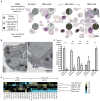A plant-like kinase in Plasmodium falciparum regulates parasite egress from erythrocytes
- PMID: 20466936
- PMCID: PMC3109083
- DOI: 10.1126/science.1188191
A plant-like kinase in Plasmodium falciparum regulates parasite egress from erythrocytes
Abstract
Clinical malaria is associated with the proliferation of Plasmodium parasites in human erythrocytes. The coordinated processes of parasite egress from and invasion into erythrocytes are rapid and tightly regulated. We have found that the plant-like calcium-dependent protein kinase PfCDPK5, which is expressed in invasive merozoite forms of Plasmodium falciparum, was critical for egress. Parasites deficient in PfCDPK5 arrested as mature schizonts with intact membranes, despite normal maturation of egress proteases and invasion ligands. Merozoites physically released from stalled schizonts were capable of invading new erythrocytes, separating the pathways of egress and invasion. The arrest was downstream of cyclic guanosine monophosphate-dependent protein kinase (PfPKG) function and independent of protease processing. Thus, PfCDPK5 plays an essential role during the blood stage of malaria replication.
Figures



Comment in
-
Signalling the great escape.Nat Rev Microbiol. 2010 Jul;8(7):464. doi: 10.1038/nrmicro2398. Nat Rev Microbiol. 2010. PMID: 21394953 No abstract available.
Similar articles
-
Calcium-Dependent Protein Kinase 5 Is Required for Release of Egress-Specific Organelles in Plasmodium falciparum.mBio. 2018 Feb 27;9(1):e00130-18. doi: 10.1128/mBio.00130-18. mBio. 2018. PMID: 29487234 Free PMC article.
-
Influence of Plasmodium falciparum Calcium-Dependent Protein Kinase 5 (PfCDPK5) on the Late Schizont Stage Phosphoproteome.mSphere. 2020 Jan 8;5(1):e00921-19. doi: 10.1128/mSphere.00921-19. mSphere. 2020. PMID: 31915223 Free PMC article.
-
Malaria Parasite Schizont Egress Antigen-1 Plays an Essential Role in Nuclear Segregation during Schizogony.mBio. 2021 Mar 9;12(2):e03377-20. doi: 10.1128/mBio.03377-20. mBio. 2021. PMID: 33688001 Free PMC article.
-
Extensive differential protein phosphorylation as intraerythrocytic Plasmodium falciparum schizonts develop into extracellular invasive merozoites.Proteomics. 2015 Aug;15(15):2716-29. doi: 10.1002/pmic.201400508. Epub 2015 May 19. Proteomics. 2015. PMID: 25886026 Review.
-
Plasmodium Egress Across the Parasite Life Cycle.Annu Rev Microbiol. 2022 Sep 8;76:67-90. doi: 10.1146/annurev-micro-041320-020659. Epub 2022 Apr 13. Annu Rev Microbiol. 2022. PMID: 35417197 Review.
Cited by
-
Gene selective mRNA cleavage inhibits the development of Plasmodium falciparum.Proc Natl Acad Sci U S A. 2012 Apr 17;109(16):6235-40. doi: 10.1073/pnas.1203516109. Epub 2012 Apr 2. Proc Natl Acad Sci U S A. 2012. PMID: 22474358 Free PMC article.
-
Integration of population and functional genomics to understand mechanisms of artemisinin resistance in Plasmodium falciparum.Int J Parasitol Drugs Drug Resist. 2021 Aug;16:119-128. doi: 10.1016/j.ijpddr.2021.05.006. Epub 2021 May 26. Int J Parasitol Drugs Drug Resist. 2021. PMID: 34102588 Free PMC article.
-
Designing antimalarials that break into cells to lock down parasites.Proc Natl Acad Sci U S A. 2021 Jun 29;118(26):e2108103118. doi: 10.1073/pnas.2108103118. Proc Natl Acad Sci U S A. 2021. PMID: 34108246 Free PMC article. No abstract available.
-
Transmission of malaria to mosquitoes blocked by bumped kinase inhibitors.J Clin Invest. 2012 Jun;122(6):2301-5. doi: 10.1172/JCI61822. Epub 2012 May 8. J Clin Invest. 2012. PMID: 22565309 Free PMC article.
-
Calcium-dependent Protein Kinases in Malaria Parasite Development and Infection.Cell Transplant. 2020 Jan-Dec;29:963689719884888. doi: 10.1177/0963689719884888. Cell Transplant. 2020. PMID: 32180432 Free PMC article.
References
-
- Billker O, et al. Calcium and a calcium-dependent protein kinase regulate gamete formation and mosquito transmission in a malaria parasite. Cell. 2004;117:503. - PubMed
-
- Färber PM, Graeser R, Franklin RM, Kappes B. Molecular cloning and characterization of a second calcium-dependent protein kinase of Plasmodium falciparum. Mol Biochem Parasitol. 1997;87:211. - PubMed
-
- Ishino T, Orito Y, Chinzei Y, Yuda M. A calcium-dependent protein kinase regulates Plasmodium ookinete access to the midgut epithelial cell. Mol Microbiol. 2006;59:1175. - PubMed
Publication types
MeSH terms
Substances
Grants and funding
LinkOut - more resources
Full Text Sources
Other Literature Sources
Molecular Biology Databases

